FEATURED STORYMangrove protection still limited by laws

CAYMAN ISLANDS – Mangroves are still disappearing under the bulldozer, even after the National Conservation Council (NCC) adopted a Species Conservation Plan for Mangroves, because this protection is limited by the parameters of the conservation and planning laws, which do not prevent owners from developing their land in accordance with the planning laws. Department of Environment (DoE) Director Gina Ebanks-Petrie told CNS that mangroves cannot be removed without planning permission and there are now stiff penalties when they are, but once a landowner gets the green light to build on or clear mangroves from their land, then all the DoE can do is implore and encourage the owners to save these plants. Responding to public concerns that mangroves are still being cleared on an almost weekly basis, despite the roll out of the species protection plan earlier this year, the DoE director explained that the plan is “an instrument under the National Conservation Act”, so it must be compatible with the law. The conservation law operates by virtue of consultation with the planning authorities and the NCC, which has delegated the consultation function to the DoE, who are the technical experts. This means that if someone owns a tract of mangroves and they are granted planning permission to remove them, regardless of any recommendations made by the DoE, the clearance of those mangrove is lawful and the conservation plan cannot protect them, Ebanks-Petrie explained. “People misunderstand this. They think that the plan somehow allows the National Conservation Council to do more than the act can do,” she said. READ MORE GLOBAL Identifying global and local drivers of change in mangrove cover and the implications for management
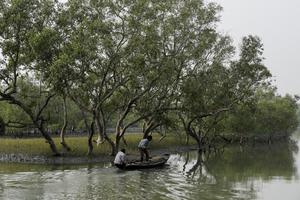
GLOBAL – Climate change and human activities continue to drive a widespread decline in global mangrove coverage, undermining their capacity to provide ecosystem benefits. While global and local scale drivers of change on mangroves are widely acknowledged, the relative importance and the exposure of mangroves to climatic, geomorphological, and direct human threats vary spatially. Understanding the role and relative importance of the multiscale and multiple threats to mangroves and how these vary spatially is fundamental for formulating a spatially adaptive approach to their management and conservation. Using satellite-derived indicators of mangrove condition aggregated over 19 years (2002 to 2019) and 14 proxies of climate, human activity, and geomorphology, we applied machine learning methods to determine the role and relative importance of the change drivers. Using outputs from this deductive statistical process, we applied inductive methods to map mangrove exposure spatially. READ MORE AFRICA Seychelles pledges to protect all mangroves, seagrass by 2030
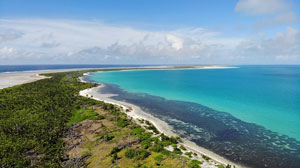
SEYCHELLES – Seychelles has pledged to protect 100 percent of its mangroves and seagrass ecosystem and reduce greenhouse gas emission by 24 percent by 2030 in its climate action plan submitted ahead of the United Nations Climate Change Conference (COP26) in Glasgow in November. The climate change and environment ministry said in a press statement on Wednesday that Seychelles submitted its updated Nationally Determined Contributions (NDCs) to the United Nations Framework Convention on Climate Change in July. The NDCs are national climate plans highlighting climate actions and targets by governments to respond to climate change. They work on a five-year cycle. The first round of submissions was in 2015 where 184 countries made their pledges. The second round was due last year, but most countries faced delays partly due to the COVID-19 pandemic. The ideal situation is for all countries to submit their commitments before the start of COP26 on November 1st where world leaders will come together to debate on climate change. READ MORE ‘Ecofeminism is about respect’: the activist working to revolutionise west African farming

SENEGAL – Outside Mariama Sonko’s home in the Casamance region of southern Senegal pink shells hang on improvised nets that will be placed in mangroves to provide a breeding spot for oysters. Normally, women collecting oysters chop at the branches – a method that can harm the mangroves. But these nets allow them to harvest sustainably, says Sonko, who is trying to revolutionise agriculture in west Africa. Sonko, 52, heads Nous Sommes la Solution (NSS, We are the Solution), an ecofeminist movement of more than 500 rural women’s associations in Senegal, Ghana, Burkina Faso, the Gambia, Guinea-Bissau, Guinea and Mali. The movement promotes sustainable agroecology and fights large-scale industrial farming. “We promote agroecology and food sovereignty in Africa. Women are invaluable actors for the development of the rural areas,” she says. READ MORE The Climate-Ecology Nexus at the IUCN World Conservation Congress

SENEGAL – Two weeks ago, I had the great privilege of attending the IUCN World Conservation Congress, running from September 3rd to the 11th. Climate change was a very evident cross-cutting theme at the meeting, right from the start. In the opening ceremony and session, President Emmanuel Macron emphatically stated France’s commitment to addressing the challenges of biodiversity and climate change at a global scale, reiterating the key policy target of ’30 by 30’, or protecting 30% of land and water by 2030. Agroecology was considered as a nature-based solution for climate change adaptation and mitigation – with inputs from the French Ministry for Agriculture, as well as the Senegalese Ministry for Agriculture; emphasizing a paradigm shift from focusing just on the performance of just a few species (and considering, for the example, the beneficial effect of wild species). More specialized thematic sessions considered, amongst others, how species conservation planning can help reverse the decline of threatened species – particularly in the context of multiple stressors, including climate change (this is obviously of particular concern in an environment where a number of CBD targets are not being achieved); learning from best practice examples around the world to improve island resilience and sustainability in a changing climate; and a session focused specifically on mangroves – drawing on the State of the World’s Mangroves report to consider how mangrove cover might be increased 20% by 2030 as an explicit climate action. READ MORE AMERICAS Rookery Bay mangrove restoration project
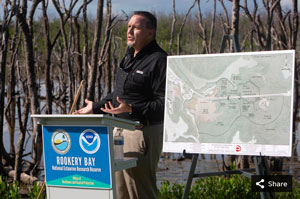
USA – The long-awaited Fruit Farm Creek Mangrove Restoration Project, the largest mangrove restoration project in the history of Florida, is about to become a reality. Rookery Bay National Estuarine Research Reserve and the Florida Department of Environmental Protection hosted a groundbreaking ceremony Friday morning at 10:00 AM at the project site on east San Marco Road. The groundbreaking was attended by many of those involved in what is being hailed as a great example of intergovernmental cooperation. Leaders, project managers, partners and elected officials from the DEP, Office of Resiliency and Coastal Protection, the Florida Wildlife Conservation Commission (FWC), the City of Marco Island and Coastal Resources Group (CSG) were on hand for the ceremony. The ceremony was staged directly in front of the ravaged mangrove basin forests that abut San Marco Road, across from Stevens Landing. On a hot summer morning with no shade, attendees got a taste of what’s in store for the workers who will be executing the restoration plan. The project was originally the dream of Robin Lewis, late board member of Mangrove Action Project. READ MORE
VIEW THE ROJECT IN PHOTOS – CLICK HERE ASIA The Huiwen wetlands: balancing conservation and aquaculture

CHINA – The Huiwen wetlands stretch 15 kilometres along the northeast coast of Hainan, from Bamen bay next to the city of Wenchang down to Fengjia bay. (The name, used locally, comes from the nearby town of Huiwen.) Varying in width from one to four kilometres, the wetlands include large areas of tidal flats and mangrove swamp, which are protected at the provincial level by the Qinglan Mangrove Reserve. They are rich in biodiversity, home to several species of mangrove and over 340 types of mangrove mollusc. And over the winter, they host huge flocks of migratory birds, including endangered species such as Nordmann’s greenshank. For years, the Qinglan reserve was also home to numerous aquaculture farms, mainly growing a species of sea snail called Babylonia lutosa. But in June this year, all 84 of the farms were removed for falling foul of China’s “ecological redline” rules against aquaculture in natural reserves. The management of Huiwen’s environment has been a focus since 2017, when the Central Supervision Office of Ecological and Environmental Protection criticised the unregulated development of aquaculture in Hainan. The farms within the Qinglan Mangrove Reserve were specifically mentioned for damaging “shelterbelts” that protect against coastal erosion and storm surges. READ MORE Saving one of the earth’s green lungs – Indonesia’s mangrove forests

INDONESIA – Indonesia, home to one of the world’s largest mangrove forests, has set a target of rehabilitating 150,000ha of its area under mangroves this year. Based on data recorded in 2011, about three million ha of mangrove forests can be found along 95,000km of Indonesia’s coastal areas, constituting 23 per cent of the world’s mangrove ecosystem. Papua, Kalimantan, and Sumatra Islands are the most crucial regional mangrove ecosystems. This year’s ambitious mangrove rehabilitation programme, which will be carried out particularly in critical and tsunami-prone areas, was announced by Coordinating Maritime Affairs and Investment Minister Luhut Pandjaitan. Indonesia’s mangrove forests store around 3.14 billion metric tons of carbon, or five times more carbon per hectare than highland tropical forests, says Mr Daniel Murdiyarso, a long-time principal scientist at the Centre for International Forestry Research and a leading wetlands expert. READ MORE Protecting the country through restoration: Jokowi plants mangroves with local community
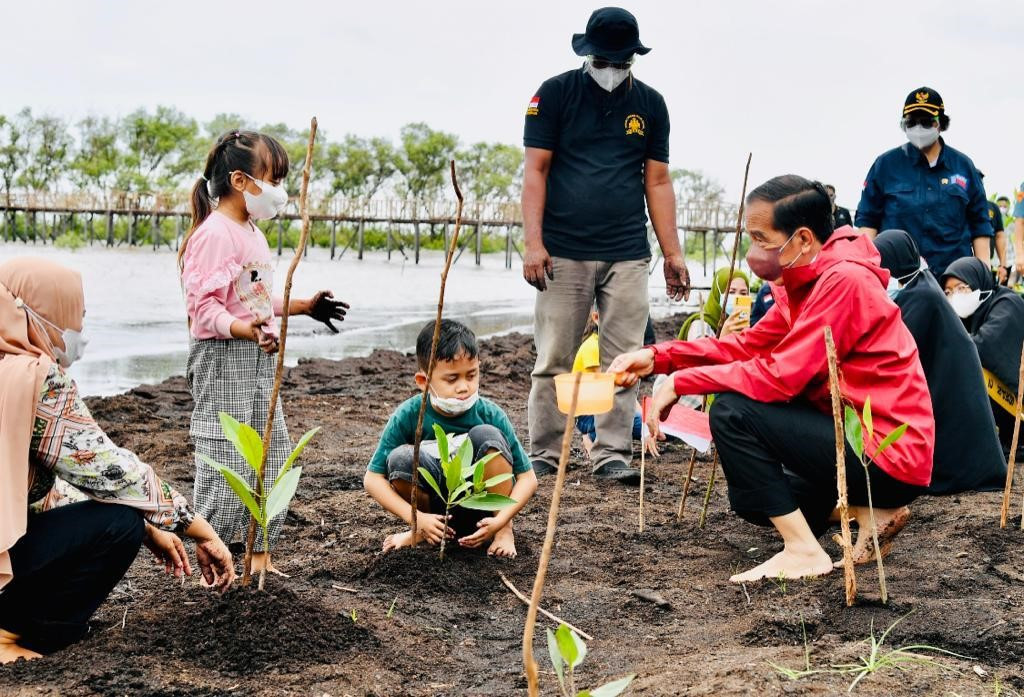
INDONESIA – President Joko “Jokowi” Widodo planted mangroves with members of the local community at Raja Kecik Beach, Muntai Barat village, Bengkalis regency, Riau, on Sept. 28, accompanied by the environment and forestry minister and the head of Mangrove and Peatland Restoration Agency (BRGM), Hartono. Jokowi said the government would rehabilitate mangrove forests and land throughout the country covering an area of 34,000 hectares by the end of 2021. According to Jokowi, mangrove rehabilitation is a strategy to defend our national territory, as well as anticipating global climate change. “We’re doing this mangrove rehabilitation not only in Bengkalis regency but across Indonesia because mangroves store four to five times more carbon than tropical forests. The mangrove rehabilitation will contribute greatly to the absorption of carbon emissions and confirm our commitment to the Paris Agreement,” Jokowi said after planting the mangroves. READ MORE Tropical cyclones can improve mangrove health
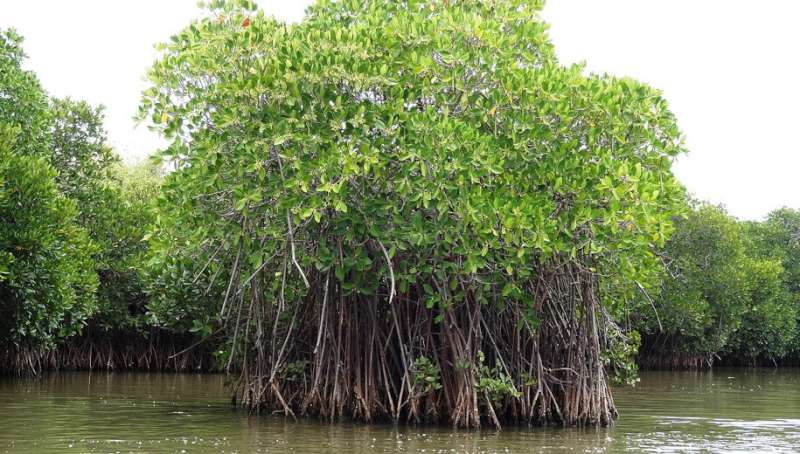
INDIA – The health of India’s mangrove forests, important to mitigate the effects of sea-level rise caused by climate warming, is influenced by tropical storms that change nutrient levels of coastal waters, according to new research. Mangrove restoration can provide mitigation and adaptation solutions to climate change and support progress towards the UN’s Sustainable Development Goals more broadly, says Wetland International, a non-profit dedicated to the conservation and restoration of wetlands. The study, published in Scientific Reports, says that mangrove ecosystems have high rates of carbon sequestration which is reflected in their vast aboveground biomass and soil carbon content. Some 57 percent of the world’s mangrove species can be found in India although the country only has about 3 percent of the world’s mangrove forests. READ MORE OCEANA Land-based and climatic stressors of mangrove cover change in the Auckland Region, New Zealand

NEW ZEALAND – Changes in mangrove forest cover (increases and decreases) have been observed globally as a result of the influence of environmental changes and human impacts. Although mangrove forest increases are globally uncommon, in New Zealand mangroves are increasing in distribution at the expense of other intertidal estuarine habitats. This study quantified the change in mangrove area over a period of 74 years (1940–2014), and investigated the influence of land-based (e.g. land use conversion in the catchments), climatic, and oceanic factors on the change in temperate mangrove forest cover in the Auckland Region of New Zealand over that period. Mangrove area increased from 2313 ha in 1940 to 10 483 ha in 2014 (on average 3.2% yr), with higher rates in small estuaries (<1000 ha) than in large estuaries (>1000 ha). The area of the intertidal mudflat habitat, i.e. potential area for mangrove colonization, has doubled from 14,193 ha in 1974 to 28,764 ha in 2014. Catchment land use, especially the clearing of forests, associated with increased sediment supply into estuaries is the strongest driver of mangrove forest gain. READ MORE
Like this newsletter?
Pease consider donating to MAP to keep it going.
Giving could never be easier  | URGENT ACTION Strengthen 60 Women Farmers in El Salvador
DONATE HERE Stop the East African Pipeline that threatens the planet #STOPEACOP – CLICK HERE Stop construction work on a private port In Defense of the Quilombo Boca Do Rio TAKE ACTION! Tell Sumitomo to stop building polluting coal power in Bangladesh! TAKE ACTION!
Like this newsletter? Pease consider donating to MAP to keep it going. Giving could never be easier
13 Year old Linda Li “Mangrove Adventure” from Kid Dream Art School

WATCH NOW 
Restoring The Natural Mangrove Forest
Watch movie 
Community Based Ecological Mangrove Restoration in Rufiji Delta VIEW VIDEO Video: Mangroves for the Future – A look bacK. As the latest phase of Mangroves for the Future (MFF) draws to a close, this video highlights some of the project’s most successful initiatives – from local women supporting national park management in Viet Nam to an island in the Maldives that has become a model for waste management, and everything in between. View Here WANT TO GET INVOLVED?
Follow and Join MAP!    
Like this newsletter? Pease consider donating to MAP to keep it going. Giving could never be easier 

Singing for the Sundarbans WATCH HERE Entrevista con Monica Quarto del Mangrove Action Project (Spanish language) Oye Aqui
VOLUNTEER OPPORTUNITY 
MANGROVE ISSUES Want to learn more about mangroves?
Our short presentation will give you a better understanding of the issues we are working to solve. WATCH PRESENTATION What is CBEMR? Download MAP’s 2 page CBEMR Information Sheet containing links to all MAP’s CBEMR resources – CLICK HERE
View MAP’s uploaded Videos at
MAP Video Gallery Question Your Shrimp Consumer/Markets Campaign!
WATCH VIDEO Mangroves: Guidebook to Malaysia – Click Here SHARE MAP’S VISION
CLICK HERE to watch short introductory video. Together we can work “at the roots of the sea”. Our short documentary, Reducing the Risk of Disaster through Nature-Based Solutions : Mangroves

Marvellous Mangroves Curriculum The Marvellous Mangroves Curriculum begins with a simple philosophy – getting future generations to not only learn about, but understand the importance of mangrove forests. VISIT 
The award-winning Marvellous Mangroves (MM) curriculum educates children on the importance of mangroves and their ecological functions, teaching them about modern challenges and mechanisms for sustainability. VIEW VIDEO Marvellous Mangroves Curriculum in Bangladesh – WATCH VIDEO
MARVELLOUS MANGROVES IN BRAZIL
En Portuges 
Marvellous Mangroves – A Curriculum-Based Teachers Guide.
Like this newsletter? Pease consider donating to MAP to keep it going. Giving could never be easier 
“Question Your Shrimp” Campaign Question Your Shrimp – is it really sustainable? Sign the Petition
Note to Our Readers: We strive to keep active links in our newsletter. However, due to circumstances beyond our control, occasionally links to stories may become broken. If you find a link to a story is not functioning, please cut and paste the headline into your browser search bar. In most cases you should be able to locate the original story.
Not yet a MAP News subscriber?
Click here to subscribe. 
|


























